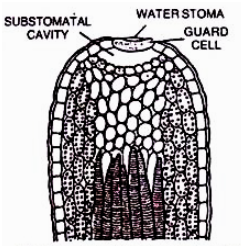Consider the given two statements:
I. Collenchyma cells in plants are well adapted for the support of young, growing organs.
II. They can continue to develop thick flexible walls while the organ is still elongating.
1. Both I and II are correct and II explains I
2. Both I and II are correct but II does not explain I
3. I is true but II is false
4. Both I and II are false
I. Collenchyma cells in plants are well adapted for the support of young, growing organs.
II. They can continue to develop thick flexible walls while the organ is still elongating.
2. Both I and II are correct but II does not explain I
3. I is true but II is false
4. Both I and II are false
Consider the given two statements:
I. Vessel elements are generally thought to be more efficient conductors of water than the tracheids.
II. Vessel elements, with their open systems, are more safe for plants than tracheids.
1. Both I and II are correct and II explains I
2. Both I and II are correct but II does not explain I
3. I is true but II is false
4. Both I and II are false
Consider the given two statements:
I. Xylem is dubbed as the ‘superinformation highway’ in plants.
II. Long distance signaling in plants occurs predominantly through xylem.
1. Both I and II are correct and II explains I
2. Both I and II are correct but II does not explain I
3. I is true but II is false
4. Both I and II are false
The given special structure is seen mainly in:

1. Grasses
2. Aquatic plants
3. Xerophytic plants
4. Mangroves
What would be true for both companion cells and albuminous cells?
I. They are derived from same mother cell as their associated cells.
II. Both contain a nucleus.
III. Both die when their associated cells die.
1. Only I and II
2. Only I and III
3. Only II and III
4. I, II and III
The given diagram shows the central core of root in a certain plant. P is phloem and protoxylem elements and V is metaxylem. What is correct for structures indicated by arrows?
1. They show aerenchyma essential for aeration of root cells
2. They show cells in the roots that contain chloroplast
3. They show cells lack the characteristic radial and inner tangential wall thickening which is common to endodermal cells
4. They show cells that store resins and oils in the roots
In the transverse section of a monocot root given below, identify A, B, C and D:
| A | B | C | D | |
| 1. | Epidermis | Exodermis | Endodermis | Pericycle |
| 2. | Exodermis | Epidermis | Endodermis | Pericycle |
| 3. | Epidermis | Exodermis | Pericyle | Endodermis |
| 4. | Exodermis | Epidermis | Pericyle | Endodermis |

To unlock all the explanations of 38 chapters you need to be enrolled in MasterClass Course.

To unlock all the explanations of 38 chapters you need to be enrolled in MasterClass Course.
Identify the correct statement regarding A and B [types of concentric vascular bundles] in the given diagram:
1. A is Amphivasal and found in Dracaena while B is amphicribal and found in Selaginella
2. A is Amphivasal and found in Selaginella while B is amphicribal and found in Dracaena
3. A is Amphicribal and found in Dracaena while B is amphivasal and found in Selaginella
4. A is Amphicribal and found in Selaginella while B is amphivasal and found in Dracaena
Identify the option where the difference between the vascular bundles of Dicot and Monocot stem is not correctly mentioned:
|
|
Dicot stem |
Monocot stem |
|
1. |
Collateral and open |
Collateral and closed |
|
2. |
Arranged in a ring |
Scattered |
|
3. |
Larger toward the center |
Of uniform size |
|
4. |
Phloem parenchyma present |
Phloem parenchyma absent |

To unlock all the explanations of 38 chapters you need to be enrolled in MasterClass Course.

To unlock all the explanations of 38 chapters you need to be enrolled in MasterClass Course.
Identify the option where the difference between the anantomy of Dicot and Monocot root is not correctly mentioned:
|
Dicot root |
Monocot root |
||
|
1. |
Xylem bundles |
Numerous |
Vary between 2 and 6 |
|
2. |
Pith |
Small/absent |
Large/well developed |
|
3. |
Pericycle |
Gives rise to lateral roots, cambium and cork cambium |
Gives rise to lateral roots only |
|
4. |
Cambium |
Appears later as a secondary meristem |
Altogether absent |

To unlock all the explanations of 38 chapters you need to be enrolled in MasterClass Course.

To unlock all the explanations of 38 chapters you need to be enrolled in MasterClass Course.










